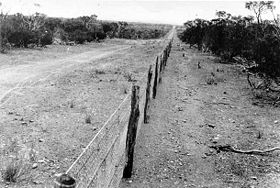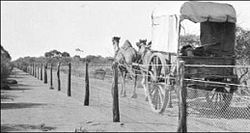
Rabbit-proof fence
Encyclopedia

The State Barrier Fence of Western Australia, formerly known as the No. 1 Rabbit-proof Fence, the State Vermin Fence and the Emu Fence, is a pest-exclusion fence
Pest-exclusion fence
thumb|280px|Xcluder pest-exclusion fence around perimeter of [[Maungatautari Restoration Project|Maungatautari]]A pest-exclusion fence is built to exclude certain types of animal pests from an enclosure...
constructed between 1901 and 1907 to keep rabbit
Rabbit
Rabbits are small mammals in the family Leporidae of the order Lagomorpha, found in several parts of the world...
s and other agricultural pests, from the east, out of Western Australia
Western Australia
Western Australia is a state of Australia, occupying the entire western third of the Australian continent. It is bounded by the Indian Ocean to the north and west, the Great Australian Bight and Indian Ocean to the south, the Northern Territory to the north-east and South Australia to the south-east...
n pastoral areas.
There are three fences in Western Australia: the original No. 1 Fence, which crosses the state from north to south, the No. 2 Fence which is smaller and further west, and the smaller east-west running No. 3 fence. The fences took six years to build. When completed in 1907, the Rabbit-Proof Fence (including all three fences) stretched 2,021 miles (3,253 km). The cost to build the fences at the time was £337,841.
Construction
The fence posts are placed 12 feet (3.7 m) apart, and have a minimum diameter of 4 inches (10.2 cm). There were initially three wires of 12½ gauge placed at 4 inches (10.2 cm), 20 inches (50.8 cm), and 3 feet (91.4 cm) above ground, with a barbed wire added later at 3'4" and a plain wire at 3'7" to make the fence a barrier for dingoDingo
The Australian Dingo or Warrigal is a free-roaming wild dog unique to the continent of Australia, mainly found in the outback. Its original ancestors are thought to have arrived with humans from southeast Asia thousands of years ago, when dogs were still relatively undomesticated and closer to...
es and fox
Fox
Fox is a common name for many species of omnivorous mammals belonging to the Canidae family. Foxes are small to medium-sized canids , characterized by possessing a long narrow snout, and a bushy tail .Members of about 37 species are referred to as foxes, of which only 12 species actually belong to...
es as well. Wire netting was placed on this, which extended to 6 inches (15.2 cm) below ground.
The fence was constructed with different materials due to the local climate, and availability of wood
Wood
Wood is a hard, fibrous tissue found in many trees. It has been used for hundreds of thousands of years for both fuel and as a construction material. It is an organic material, a natural composite of cellulose fibers embedded in a matrix of lignin which resists compression...
. At first salmon gum and gimlet wood were used, although these attracted white ants and had to be replaced. Split white gum was one of the best types of wood used in the fence. Others used were mulga
Mulga
Acacia aneura, commonly known as Mulga or True Mulga, is a shrub or small tree native to arid outback Australia of areas such as the Western Australian Mulga shrublands.-Description:...
, wodjil, pine
Pine
Pines are trees in the genus Pinus ,in the family Pinaceae. They make up the monotypic subfamily Pinoideae. There are about 115 species of pine, although different authorities accept between 105 and 125 species.-Etymology:...
, and Tea tree
Melaleuca
Melaleuca is a genus of plants in the myrtle family Myrtaceae known for its natural soothing and cleansing properties. There are well over 200 recognised species, most of which are endemic to Australia...
, based on where it could be found close to where the fence was to be built. Iron was used in parts where there was no wood.
Maintenance

The camels were used as pack animals, especially in the north, while in the south, camels were used to pull drays with supplies for the riders. Camels were ideal for this as they could go for a long time without water, and it has been suggested that the fence could not have been built or maintained without the use of camels.
In addition to Crawford, there were four sub-inspectors, each responsible for about 800 kilometres (497.1 mi) of fence, and twenty-five boundary riders who regularly patrolled 160 kilometres (99.4 mi) sections of fence. Due to frontier violence in the north of the state, a 500 kilometres (310.7 mi) section of the No.1 fence was patrolled by riders in pairs.
Crawford was responsible for eliminating rabbits which had breached the fence. In the first year following the completion of the fences, colonies were found and destroyed near several locations inside the fence, including Coorow
Coorow, Western Australia
Coorow is a town in the Mid West region of Western Australia, north of Perth.The townsite of Coorow was gazetted in 1893, and the name is derived from the Aboriginal name of a nearby spring, first recorded in 1872...
, Mullewa
Mullewa, Western Australia
- External links :* *...
and Northampton
Northampton, Western Australia
Northampton is a town north of Geraldton, in the Mid West region of Western Australia. At the 2006 census, the town had a population of 813. It is historic, with an outstanding National Trust building. The town lies on the North West Coastal Highway. Formerly named Gwalla after the location's...
.
Following the introduction of Myxomatosis
Myxomatosis
Myxomatosis is a disease that affects rabbits and is caused by the Myxoma virus. It was first observed in Uruguay in laboratory rabbits in the late 19th century. It was introduced into Australia in 1950 in an attempt to control the rabbit population...
to control rabbits in the 1950s, the importance of the Rabbit Proof Fence diminished.
Cultural references

Arthur Upfield
Arthur William Upfield was an Australian writer, best known for his works of detective fiction featuring Detective Inspector Napoleon Bonaparte of the Queensland Police Force, a half-caste Aborigine....
, an Australian writer, began writing a fictional story which involved a way of disposing of a body in the desert. He had previously worked on the construction of the No. 1 fence. Before the book was published, stockman Snowy Rowles, an acquaintance of the writer, carried out at least two murders and disposed of the bodies in the method described in the book. The trial which followed in 1932 was one of the most sensational in the history of Western Australia. A book was published about the incident called Murder on the Rabbit Proof Fence: The Strange Case of Arthur Upfield and Snowy Rowles. The incident is now referred to as The Murchison Murders
The Murchison Murders
The Murchison Murders were a series of three murders, committed by an itinerant stockman named Snowy Rowles, near the Rabbit-proof fence in Western Australia during the early 1930s...
.
In the book Follow the Rabbit-Proof Fence
Follow the Rabbit-Proof Fence
Follow the Rabbit-Proof Fence is an Australian book by Doris Pilkington. Based on a true story, the book is a personal account of an Indigenous Australian family's experiences as members of the "Stolen Generation" – the forced removal of mixed-race children from their families during the...
by Doris Pilkington Garimara
Doris Pilkington Garimara
Doris Pilkington Garimara AM is an Australian author. She is best known for her 1996 book Follow the Rabbit-Proof Fence, a story of three Aboriginal girls, among them Pilkington's mother Molly Craig, who escaped from the Moore River Native Settlement in Western Australia and travelled for nine...
, the fence was used in the 1930s by three Indigenous Australian
Indigenous Australians
Indigenous Australians are the original inhabitants of the Australian continent and nearby islands. The Aboriginal Indigenous Australians migrated from the Indian continent around 75,000 to 100,000 years ago....
girls for their route back home to Jigalong. The girls, taken from their parents in Western Australia
Western Australia
Western Australia is a state of Australia, occupying the entire western third of the Australian continent. It is bounded by the Indian Ocean to the north and west, the Great Australian Bight and Indian Ocean to the south, the Northern Territory to the north-east and South Australia to the south-east...
as part of the Stolen Generation
Stolen Generation
The Stolen Generations were the children of Australian Aboriginal and Torres Strait Islander descent who were removed from their families by the Australian Federal and State government agencies and church missions, under acts of their respective parliaments...
, escaped from the Moore River Native Settlement
Moore River Native Settlement
The Moore River Native Settlement was the name of the now defunct Aboriginal settlement and internment camp located north of Perth and west of Mogumber in Western Australia, near the headwaters of the Moore River.- Name change :...
mission
Mission (Christian)
Christian missionary activities often involve sending individuals and groups , to foreign countries and to places in their own homeland. This has frequently involved not only evangelization , but also humanitarian work, especially among the poor and disadvantaged...
where they were being held and walked back to their family at Jigalong by following the rabbit-proof fence. The book was made into a film
Rabbit-Proof Fence (film)
Rabbit-Proof Fence is a 2002 Australian drama film directed by Phillip Noyce based on the book Follow the Rabbit-Proof Fence by Doris Pilkington Garimara...
in 2002.
See also
- Temporary fencingTemporary fencingTemporary Fence is used where building a permanent fence is either impractical or unneeded. Temporary fencing is used when an area needs barriers for the purposes of public safety or security, crowd control, theft deterrent, or equipment storage. Its most common use is as construction hoarding for...
- Agricultural fencingAgricultural fencingIn agriculture, fences are used to keep animals in or out of an area. They can be made from a wide variety of materials, depending on terrain, location and animals to be confined...
- Dingo FenceDingo FenceThe Dingo Fence or Dog Fence is a pest-exclusion fence that was built in Australia during the 1880s and finished in 1885, to keep dingoes out of the relatively fertile south-east part of the continent and protect the sheep flocks of southern Queensland. It is one of the longest structures in the...
- Rabbits in AustraliaRabbits in AustraliaIn Australia, rabbits are a serious mammalian pest and are an invasive species. Annually, European rabbits cause millions of dollars of damage to crops.-Effects on Australia's ecology:...
External links
- The No.1 Rabbit Proof Fence
- Run Rabbit Run! Australian Museums and Galleries
- The State Barrier Fence of Western Australia Pandora Online Archive
- The Rabbit Proof Fence Library of West Australian History
- At Australia’s Bunny Fence, Variable Cloudiness Prompts Climate Study The New York Times

